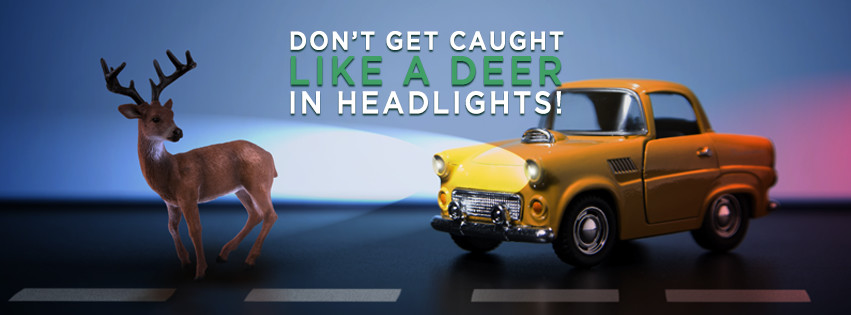
Ah, Fall. It’s that time of year again: changing leaves, chilly air, football games, and pumpkin patches. This season also marks the beginning of mating season for deer, causing them to roam farther from their normal territory and onto our roadways. Fall also coincides with both hunting season and harvest, increasing the likelihood that deer will be on the move and crossing our path in higher numbers. Your odds of encountering a deer while driving jump dramatically in the months of October and November. Last year, Missouri drivers reported nearly 4,000 deer-related accidents.
Deer-related accidents are not only very dangerous, but can also lead to very costly repairs. Most likely, any auto fixes you would need as a result of a collision with a deer would be covered by the Comprehensive coverage on your auto insurance policy. However, if your auto policy doesn’t carry Comprehensive coverage, you would be responsible for the cost of any damages out of pocket. As neither Missouri or Illinois require Comprehensive coverage, it may be a good time to check your policy and make adjustments.
Most of the problems we see as a result of deer-related accidents affect the front-end of vehicles. Replacements or repairs commonly seen because of serious front end damage are:
· Front bumpers
· Hoods
· Fenders
· Headlights
However, depending on the point and speed of impact, repairs can extend to other parts of your vehicle including your windshield or even a side panel. The average cost of deer-related collision repairs could be anywhere from $2,000 all the way up to $10,000 depending on the severity of the accident. Not to mention the time it takes for repairs, which could leave you without your car for several days.
To help you avoid a potentially dangerous and costly accident with a deer, here are a few things to remember about driving this time of year.
Be Cautious
States are constantly working on updating road signs to clearly mark places where deer are more common. Although paying close attention when you see these signs is a great start, you should also be on the lookout in other places, particularly on wooded roadways or in rural areas near fields. Remember, deer tend to travel in groups so if you see one, odds are that there are more nearby.
They’re Just As Scared Of You
Never underestimate the power of honking your horn. If a deer-accident seems imminent, making a sudden noise might be just the start a deer needs to hop out of the way.
Use Your High Beams
The majority of accidents involving deer happen at night. In fact, dusk and dawn are particularly dangerous. Knowing when and how to best use your headlights can help you avoid an unnecessary accident. Keep in mind that the first sight of a deer is often your headlights reflecting in their eyes. Use your high beams whenever possible to help you see farther and give you more time to safely slow down if you see a deer in your path.
Pick The Center Lane
On multi-lane highways, the center lane is the best place to travel to avoid a deer collision. Deer will have to cross through the other lanes to get to a point of contact with your car, giving you more time to notice them.
Brake Safely
If you see a deer and have plenty of time to slow down, be cautious and slow down safely. However if you see a deer in your immediate path, don’t overreact by swerving off the road. This could be even more dangerous for you. Do your best to brake as quickly and calmly as possible, keeping in mind the cars around you. Remaining in control of your vehicle and staying on the road despite a potential collision with the deer is much safer for you and other drivers.
We hope you never have to use this service, but if you are in an accident involving a deer, we’re here to help. Our team of experts is uniquely prepared to help you get your car back to working order with as little hassle as possible.

